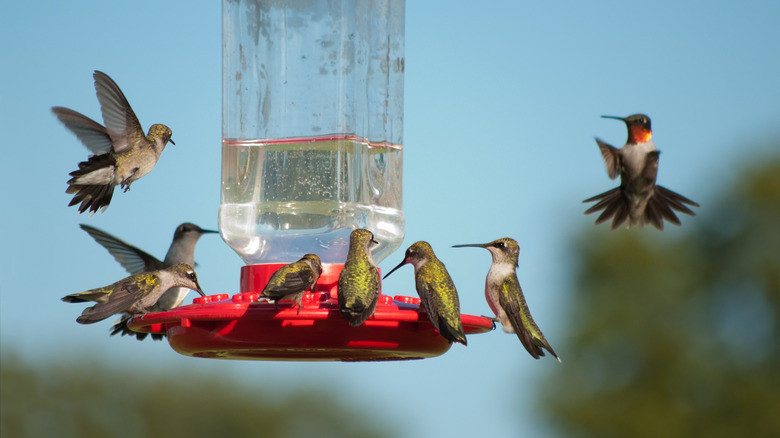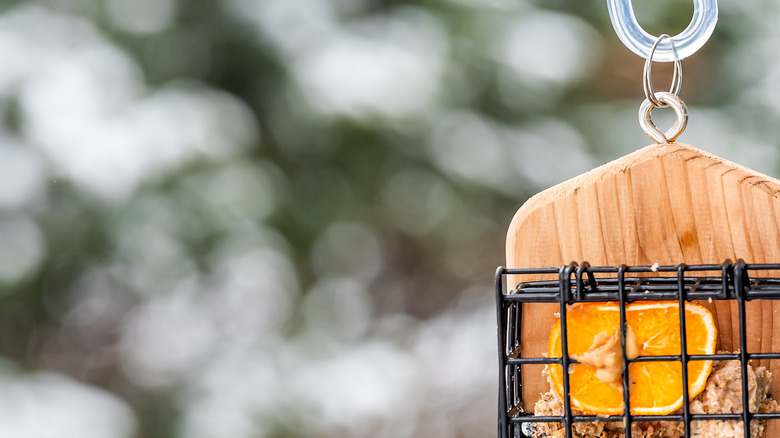Hang This Fruit In Your Tree And Hummingbirds Will Flock To Your Yard
If you're interested in feeding the birds in your backyard, you probably already know that some birds prefer seeds while others prefer sweet treats like nectar and fruit. For example, orioles, woodpeckers, and tanagers (among other birds) can't resist a citrus slice. It's less well-known that hummingbirds will dine on the fructose-filled juice of fresh oranges and other fruit. There, however, lies the flutter. Oranges aren't a hummer's preferred food. If there are other options — like, say, commercial nectar or homemade sugar water — at a feeder, they'll gravitate to that first. Does that mean you shouldn't put out oranges for hummingbirds? Not quite!
The idea that hummingbirds sip from orange halves probably stems from a few (legitimate) tidbits of expert hummer knowledge. For one, it's well-documented, as a paper published in the journal Desert Plants way back in 1981 proves, that hummingbirds prefer to feed on "flowers in the red-yellow segment of the color spectrum" — that is, yellow, red, and, importantly for this discussion, orange-hued flowers. That's why most commercial hummingbird feeders feature bright red landing pads or nectar receptacles. An orange half is, of course, dramatically coral-hued. On the subject of feeders, it's also possible their design contributed to the popularity of oranges — many have a fruit spike or two next to the nectar pots. If there's a spot for an orange in a bird feeder, it's only natural that backyard birders will want to fill it with an orange!
Insects over nectar
Just as an overripe banana is the secret to attracting more hummingbirds to your yard, oranges may do the same. It turns out that our backyard's teeny, feathered fliers might not like the orange itself; they're here to hunt fruit flies and other fructose-loving insects the sickly sweet fruit attracts. It might be surprising to learn that insects and arachnids comprise an incredible 80% of a hummingbird's diet, per UC ANR's Bug Squad blog. The remaining 20% is nectar. They feast on exoskeletal treats to get the protein they need to sustain muscle and feather growth; insects also provide essential nutrients like amino acids, fats, and salts, which they can't get from nectar (and definitely not from sugar water). Hummers that appear to be drinking from orange halves may, in fact, be snapping insects from the air.
If you want to put a cut-open orange out for hummingbirds, go for it. It's certainly not going to harm the creatures. The worst that could happen is they completely ignore it. Plus, you might attract other equally wonderful feathered friends who like oranges more. Choose ripe, soft, sweet fruit for maximum juice — and insect attraction — potential. Cut up or peel the fruit wherever possible to reveal as much of the edible part as possible. Hammer a nail into a backyard tree at an upward-facing angle, then slide half an orange or a collection of orange wedges or slices onto it.
How to put oranges out
Another easy way to make a bird feeder is to put orange wedges into a small mesh produce bag and hang it from a tree branch. To maximize visitations, pair this with a nectar-filled hummingbird feeder. Alternatively, involve the kids and make an orange bird feeder "wreath." Break apart a coat hanger and bend the non-hook end upward to form an open-ended circle. Thread orange slices onto the wire and hang the wreath from a branch.
If you prefer something ready-made, there are plenty of commercial fruit feeders. The National Wildlife Federation sells a hanging fruit and jelly feeder with space for two orange halves for $22.99. Or, pop chopped oranges inside the wasp-proof Humm-Bug protein hummingbird feeder — $32.50 from The Birdhouse Chick. Whatever method you choose, hang or hammer the fruit in an open area where hummingbirds can easily spot approaching predators. Switch out the fruit and clean and disinfect spikes and trays regularly to prevent contamination and the spread of disease. Never use dried fruit — the added sugar is bad for birds.
As the introduction mentions, hang an orange in your backyard, and orioles, woodpeckers, verdin, and tanagers are among a handful of fruit-loving birds you might find visiting your hummingbird feeders. Don't panic if they show up. The diminutive hummingbird can be quite the bully when someone gets between it and its dinner. They've been known to battle with — and win against — warblers, wrens, and more.


